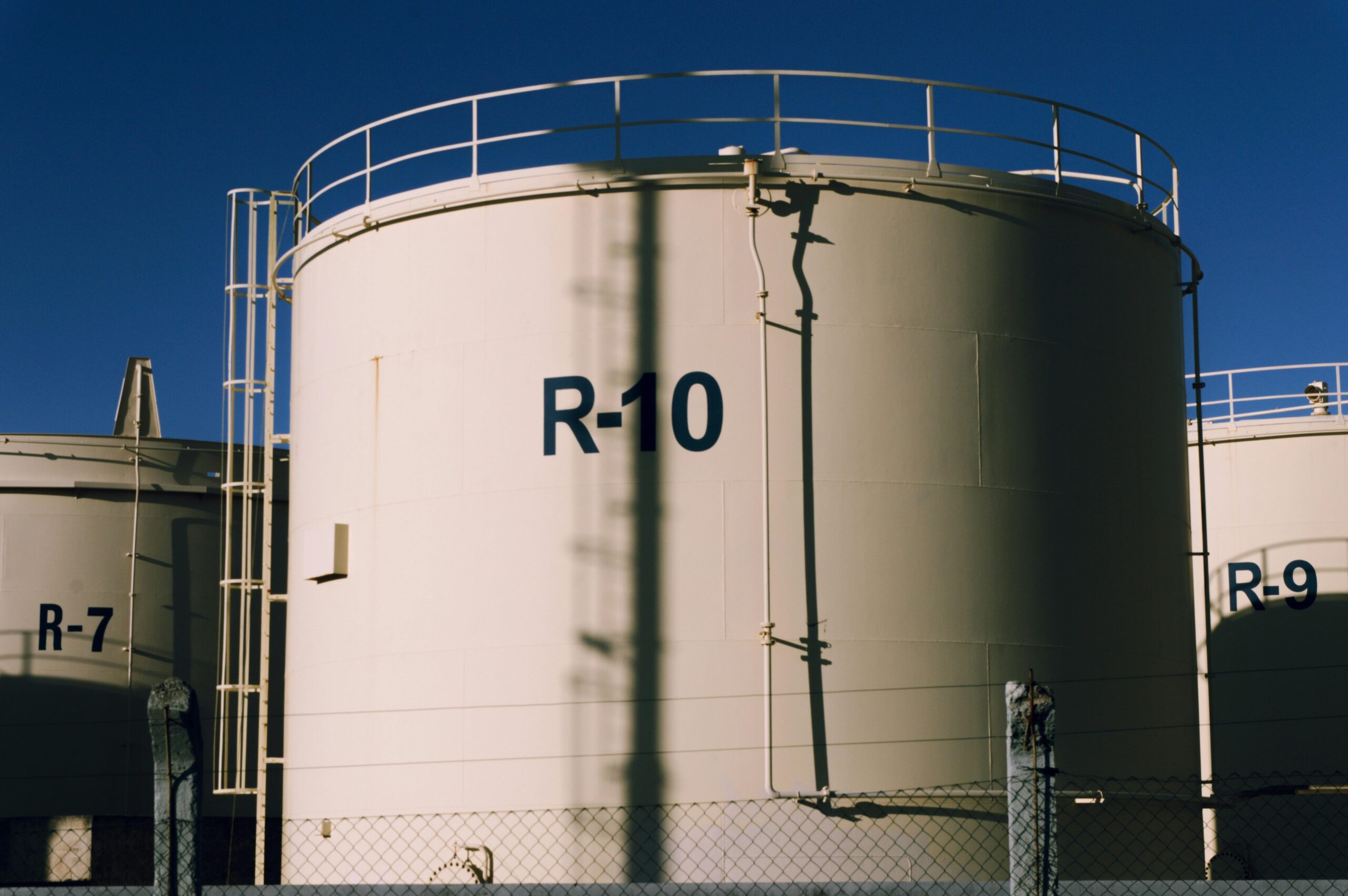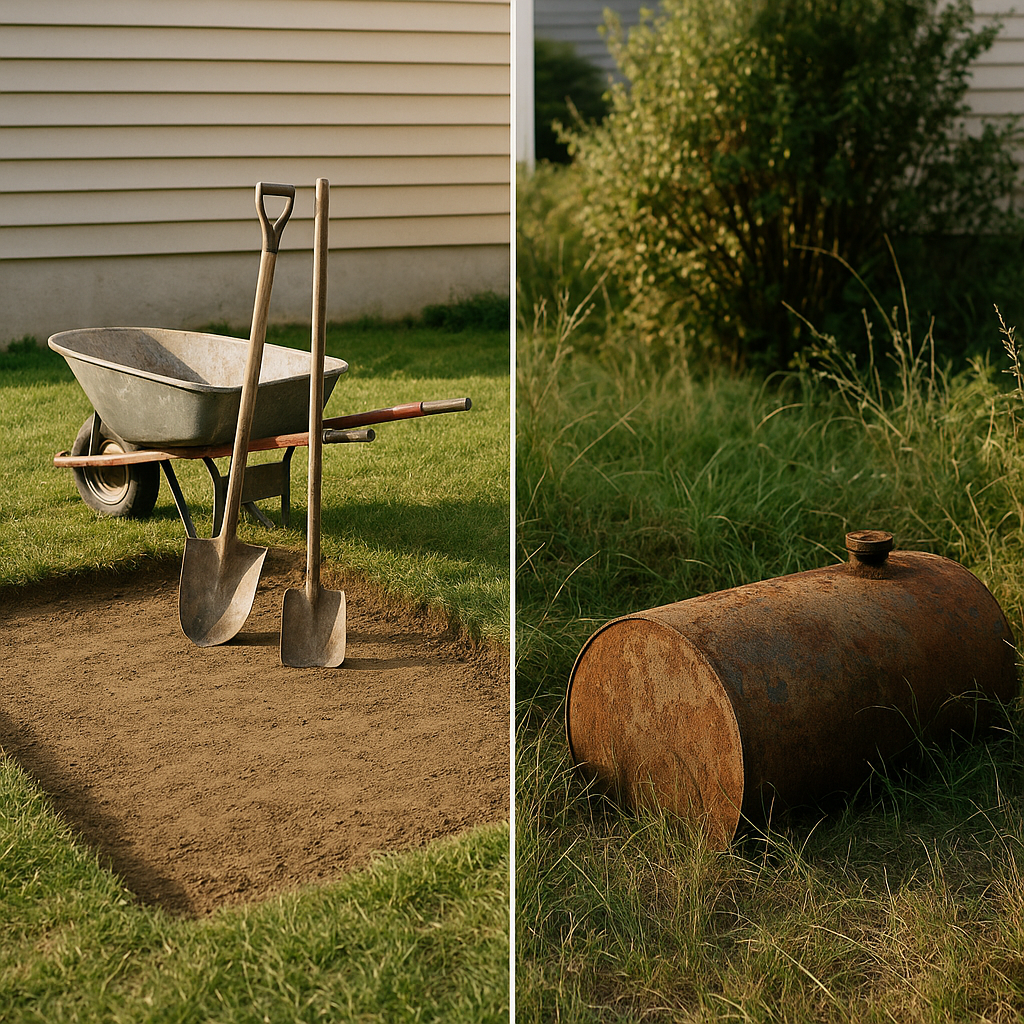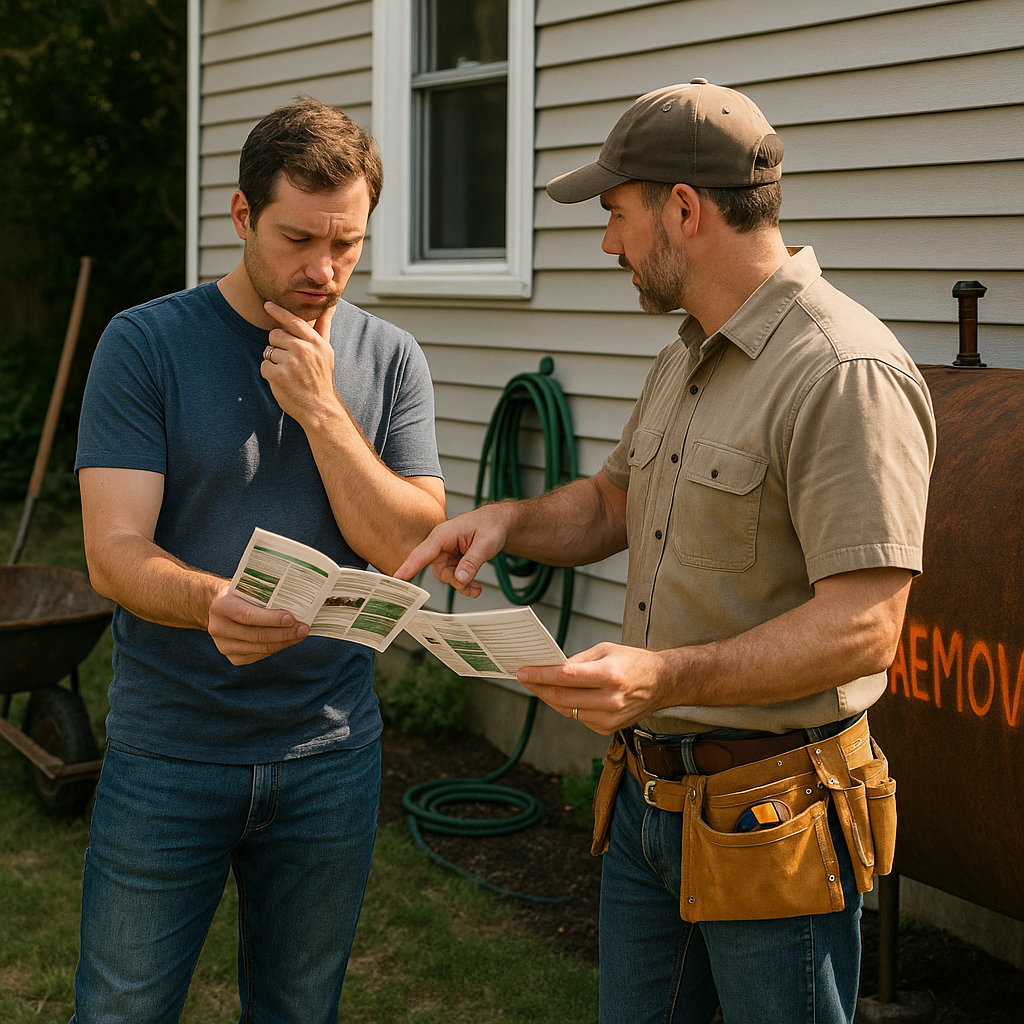5901 Botham Jean Blvd, Dallas, TX 75215
Discover the Options Available for Retired Oil Storage Tanks?
August 6, 2025Facing the challenge of what to do with an aging oil storage tank is a common dilemma for many property owners. These tanks, whether underground or aboveground, eventually reach the end of their useful life and require action. If left unattended, they can pose environmental risks and potential financial liabilities.
Oil storage tanks naturally deteriorate over time due to environmental factors. Soil acidity, moisture levels, and age all contribute to the breakdown of tank materials. This deterioration is particularly concerning for underground storage tanks, which are typically made of steel and prone to corrosion.
Fortunately, property owners have several practical options when dealing with retired oil tanks. Each approach offers different benefits and considerations depending on the specific situation. Understanding these options is the first step toward making an environmentally responsible and cost-effective decision.
How Can Retired Oil Tanks Be Safely Decommissioned?

The decommissioning of retired oil tanks requires meticulous planning and execution to prevent environmental contamination. Whether dealing with underground or aboveground storage tanks, proper procedures must be followed to ensure safety and regulatory compliance.
The Tank Decommissioning Process
Safe decommissioning follows a structured approach that addresses both environmental safety and regulatory requirements. Professional contractors typically implement these key steps to properly retire tanks.
First, all remaining oil must be extracted from the tank. Removing the oil at this stage prevents potential leaks during subsequent phases of decommissioning. Contractors use specialized explosion-proof pumps to remove usable oil, which can often be filtered and recycled.
Once the reusable oil is removed, attention turns to the sludge that accumulates at the bottom of tanks. This thick mixture of rust, water, bacteria, and other contaminants requires careful handling.
- Technicians cut open the tank using metal cutting blades
- Sludge is manually scraped out and transferred to sealed drums
- The collected waste is properly transported for specialized processing
- The tank interior is thoroughly cleaned to remove residual contaminants
Removal vs. Abandonment In Place
Tank owners face two primary options: complete removal or abandonment in place. Complete removal allows visual inspection of the surrounding soil for contamination but is more costly.
For tanks abandoned in place, contractors must:
- Drain and flush all connected piping into the tank
- Remove all fill tubes and disconnect fill, gauge, and product lines
- Cap or plug open ends of lines not being used further
- Fill the tank completely with an inert material like sand or concrete slurry
Soil sampling around the tank is often necessary to check for potential leakage, especially if any holes are discovered during the process. The presence of petroleum in soil samples must be reported to environmental authorities.
Professional Handling and Disposal
Proper disposal of the decommissioned tank is the final critical step. Tanks cannot simply be discarded as regular waste due to contamination concerns. Professional contractors transport tanks to approved hazardous waste facilities for proper treatment.
For underground storage tanks (USTs), the process is more complex. The EPA estimates UST removal costs between $10,000 and $1 million, with an average of $130,000 depending on contamination levels and local cleanup standards. Aboveground storage tanks typically have lower decommissioning costs, averaging around $2,600 in some regions.
Regulatory Compliance
Strict regulations govern tank decommissioning. In many states, homeowners must register underground tanks and disclose their presence when selling property. Environmental agencies require notification before permanent tank closure, with documentation of the process maintained for at least three years.
States like Oregon require licensing for professional decommissioning services. Even where homeowners can legally handle their own tank decommissioning, the complex regulations and safety concerns make professional services advisable.
Testing throughout the decommissioning process ensures all hazardous materials are properly contained. This includes checking for vapor levels and ensuring the tank atmosphere is safe before proceeding with each step.
The environmental impact of improper tank decommissioning can be severe. Leaking tanks may contaminate soil and groundwater, potentially requiring extensive remediation. By following proper procedures, tank owners protect both the environment and themselves from potential liability.
What Are the Benefits and Risks of Removing vs. Leaving Tanks in Place?

When handling underground storage tanks, property owners must decide between complete removal or decommissioning the tank in place. Each option offers unique advantages and potential drawbacks, which should be considered based on environmental impact, cost considerations, and future property use.
Benefits of Complete Tank Removal
Completely removing underground tanks provides several advantages. It allows for a thorough inspection of the surrounding soil, crucial for detecting contamination that might have resulted from undetected leaks. Verifying soil quality ensures no environmental hazards remain, offering peace of mind and documentation.
Removing tanks eliminates the risk of future sinkholes. Over time, abandoned tanks can collapse, creating ground depressions that damage structures or landscaping. Complete removal eliminates this structural risk entirely.
From a property value perspective, potential buyers and mortgage lenders typically prefer removal. Financial institutions often require documentation of proper tank removal before approving loans on properties with a history of underground tanks. This documentation simplifies future property transactions.
Risks and Challenges of Tank Removal
Despite its benefits, tank removal presents challenges, primarily related to cost. Removing an underground tank can range from $1,000 to $5,000 for standard residential tanks, depending on factors like size and accessibility. If contaminated soil is found, costs can substantially increase, sometimes reaching tens of thousands for cleanup.
The removal process can also disrupt property. Heavy equipment needed for the job may damage landscaping or structures, and excavation results in ground disturbance that requires restoration.
Unexpected contamination findings during removal can delay projects and create uncertainty about costs, complicating budgeting and timelines.
Benefits of Leaving Tanks in Place
Decommissioning tanks and leaving them in place is often less expensive initially, costing 30-50% less than complete removal. This approach also minimizes property disruption as it doesn’t involve major excavation.
For tanks located under structures or landscaping, in-place decommissioning avoids significant access costs and disruptions. The process is usually faster and more predictable since it doesn’t entail extensive soil testing or remediation.
Proper decommissioning involves cleaning the tank, removing all liquids and sludge, and filling it with an inert material like sand or foam. When done correctly, this reduces immediate environmental risks.
Risks of Leaving Tanks in Place
Despite short-term benefits, leaving tanks in place has long-term risks. Without soil testing, undetected contamination may spread, reaching groundwater or neighboring properties, resulting in higher cleanup costs.
Property sales can become complicated with tanks left in place. Many buyers and lenders hesitate to accept such properties, even if decommissioned, which can lower property value and limit buyer interest.
Local regulations may change, potentially requiring future removal of tanks previously allowed to remain in place. This regulatory risk adds uncertainty about potential future costs for property owners.
Underground vs. Aboveground Tank Considerations
Underground tanks pose greater environmental risks compared to aboveground alternatives. Their buried location makes leak detection difficult, allowing small problems to escalate. Underground tanks are more vulnerable to corrosion from soil conditions and water exposure.
Many property owners opt for aboveground tanks when replacing old systems. These offer easier inspection, simpler maintenance, and straightforward replacement. Though more visible, modern aboveground tanks are designed with aesthetics and safety in mind, making them viable alternatives.
Making Your Decision
Your decision between removal and decommissioning should consider the tank’s age and condition. Older tanks, especially steel ones without corrosion protection that have been in place for over 15-20 years, present higher risks and are better candidates for removal.
Local regulations vary significantly in tank management. Some areas require removal regardless of the tank’s condition, while others permit decommissioning. It’s important to contact your local environmental agency or fire department for specific requirements.
Future property plans also play a role in your decision. If you plan to sell soon, removal typically provides the cleanest record and broadest appeal to buyers. For properties with difficult access or tanks under structures, a cost-benefit analysis may favor in-place decommissioning, especially if regulations allow.
How Can Retired Oil Tanks Be Creatively Repurposed?

Retired oil tanks offer excellent opportunities for creative reuse projects. Their sturdy construction and cylindrical shape make them versatile starting points for numerous DIY transformations. With proper preparation and safety measures, these industrial items can become useful and attractive additions to your property.
Many sustainability-minded homeowners are discovering the potential of these discarded containers. Instead of sending them to landfills, repurposing gives these tanks new life while reducing waste. This approach aligns perfectly with circular economy principles by extending the useful life of materials.
Water Collection Systems
One of the most practical repurposing options is converting oil tanks into rainwater harvesting systems. These tanks are naturally designed to hold liquids. With proper cleaning and modification, they can store substantial amounts of rainwater for garden irrigation.
Before using any tank for water collection, thorough cleaning is essential. Any oil residue must be completely removed. Some DIY enthusiasts recommend first testing the water quality by collecting a small amount and using it on non-edible plants to ensure no contamination exists.
For water collection systems, you’ll need to add an inlet connected to downspouts, an overflow valve, and a spigot at the bottom for accessing the water. Many repurposed tanks can hold hundreds of gallons, providing significant irrigation capacity during dry periods.
Outdoor Fire Features
Repurposed oil tanks make excellent outdoor fire pits or wood-burning stoves. The metal construction withstands high temperatures while containing the fire safely. Horizontal tanks can be cut lengthwise to create semi-cylindrical fire pits, while vertical tanks work well as wood-burning stoves.
Safety is paramount when creating fire features. All flammable residues must be completely removed. Some tank repurposers use a flaming rag on a long stick to burn off any remaining fuel vapor before cutting—this should only be attempted in open areas with proper safety equipment and knowledge.
Adding decorative cutouts to the sides of a fire pit tank creates attractive light patterns when the fire is burning. Star shapes, trees, and other designs can transform a simple tank into an artistic centerpiece for outdoor gatherings.
Garden Planters and Features
Oil tanks can become unique garden planters with minimal modification. Cutting the tank in half lengthwise creates two large trough planters. Smaller sections can be mounted on walls or stands for vertical gardening.
Some creative gardeners have transformed tanks into decorative garden sculptures. With basic welding skills, tanks can become animal shapes or abstract art. Examples include tanks repurposed as cattle or moose sculptures with added metal elements creating horns, legs, and other features.
For planter use, proper drainage holes are essential. The metal should also be treated to prevent rust, especially if you plan to grow edible plants. Food-grade sealants can provide an additional barrier between soil and any potential contaminants in the metal.
Furniture and Functional Items
With imagination and basic metalworking skills, oil tanks can become functional furniture. Cut sections can form the base for benches, tables, or unique seating. Adding wooden tops or cushions creates comfortable, conversation-starting pieces.
Some repurposers have created storage units, tool sheds, or even small outdoor bars from larger tanks. Vertical tanks with added shelving make excellent garden tool storage, while horizontal tanks can become unique storage benches for outdoor spaces.
The industrial aesthetic of repurposed tanks pairs well with many design styles, particularly modern, rustic, and industrial decor. Their unique character adds interest to outdoor spaces that standard furniture cannot match.
Safety Considerations
Safety must be your primary concern when repurposing oil tanks. Before beginning any project, ensure the tank is completely empty and has been properly cleaned of all oil residue. Professional cleaning is recommended for tanks that held heating oil or other fuels.
When cutting metal tanks, proper ventilation and safety equipment are essential. Metal dust and any remaining fumes can be hazardous. Always work outdoors and wear appropriate protective gear, including eye protection, gloves, and respiratory protection.
For tanks being repurposed for water collection or planters, consider testing for contaminants before use, especially if you’ll be using the water for edible plants. Some older tanks may contain lead paint or other hazardous materials that require special handling.
What Are the Legal and Environmental Considerations?

Decommissioning retired oil tanks involves dealing with a complex web of regulations aimed at protecting the environment and public health. Property owners must adhere to specific legal frameworks at multiple government levels to ensure proper tank disposal and site remediation.
Regulatory Compliance Requirements
Most states and municipalities mandate that property owners register their underground storage tanks (USTs) with the appropriate regulatory authorities. This registration process establishes an official record of the tank’s existence and condition, essential for tracking environmental liabilities. For underground tanks, regulatory oversight is particularly stringent due to their higher contamination risk.
Federal regulations established by the Environmental Protection Agency (EPA) set baseline requirements for tank decommissioning, though state and local regulations often impose additional, more stringent standards. These regulations typically specify:
- Mandatory notification periods before decommissioning begins
- Required permits and documentation
- Specific decommissioning methods based on tank type and location
- Qualification standards for contractors performing the work
Property owners should be aware that decommissioning protocols differ significantly between underground and aboveground tanks. While aboveground tanks generally face less regulatory scrutiny, they still require proper handling and disposal procedures to prevent contamination.
Environmental Assessment Requirements
Environmental site assessments are a critical part of the decommissioning process, especially for underground tanks that may have leaked over time. These assessments typically involve:
Soil sampling around the tank to detect contamination from petroleum products or other hazardous substances. This testing helps determine the extent of contamination and guides remediation efforts. For underground tanks, this often requires extracting soil samples from multiple depths and locations around the tank.
Groundwater testing may be required if soil contamination is detected or if the tank is located near water sources. Even minor leaks can lead to significant groundwater contamination, potentially affecting drinking water supplies and natural ecosystems.
If contamination is discovered during the assessment, property owners must follow state-mandated cleanup protocols. The cleanup requirements vary based on several factors, including the type and extent of contamination, proximity to water sources, and local environmental standards.
Potential Environmental Impacts
Improper handling of retired oil tanks can lead to serious environmental consequences. Leaking tanks pose significant risks to soil and groundwater quality, potentially releasing toxic substances that can persist in the environment for decades.
Oil contaminants can travel through soil and eventually reach groundwater, creating plumes of pollution that may spread far beyond the original tank location. This contamination can affect drinking water sources, wildlife habitats, and neighboring properties.
Beyond immediate environmental damage, oil tank leaks can create long-term liabilities for property owners. Cleanup costs for extensive contamination can exceed $100,000, particularly when groundwater remediation is required. This financial burden typically falls on the current property owner, regardless of when the contamination occurred.
Liability Considerations
Property owners should understand that liability for contamination extends beyond regulatory fines. They may face:
- Civil lawsuits from neighboring property owners affected by contamination
- Diminished property values and difficulties selling contaminated properties
- Potential denial of mortgage or insurance coverage
- Responsibility for cleanup costs even if the tank was installed by previous owners
Documentation of proper decommissioning is essential for protecting property owners from future liability claims. This documentation should include permits, inspection reports, soil testing results, and certification of proper disposal of both the tank and any contaminated materials.
The legal and environmental considerations surrounding oil tank decommissioning highlight the importance of working with qualified professionals who understand current regulations and best practices. By following proper procedures, property owners can ensure environmental protection while minimizing their legal and financial exposure.
Conclusion: Making an Informed Decision About Your Retired Oil Tank

Making an informed decision about your retired oil tank is vital for protecting the environment, preserving property value, and ensuring regulatory compliance. Throughout this article, we’ve explored the importance of proper tank decommissioning and the options available to property owners. It is clear that addressing an aging or unused oil tank promptly is the responsible choice, as these tanks deteriorate over time and can lead to soil and groundwater contamination.
Whether you opt for complete removal, which allows for a thorough inspection of potential contamination, or proper in-place decommissioning, working with qualified professionals ensures the process meets all local, state, and federal requirements. Remember that leaving an untreated tank in place can create potential environmental liabilities and may impact future property sales during required environmental assessments. For personalized advice tailored to your specific situation and to ensure your oil tank is handled responsibly, contact Okon Recycling at 214-717-4083.
